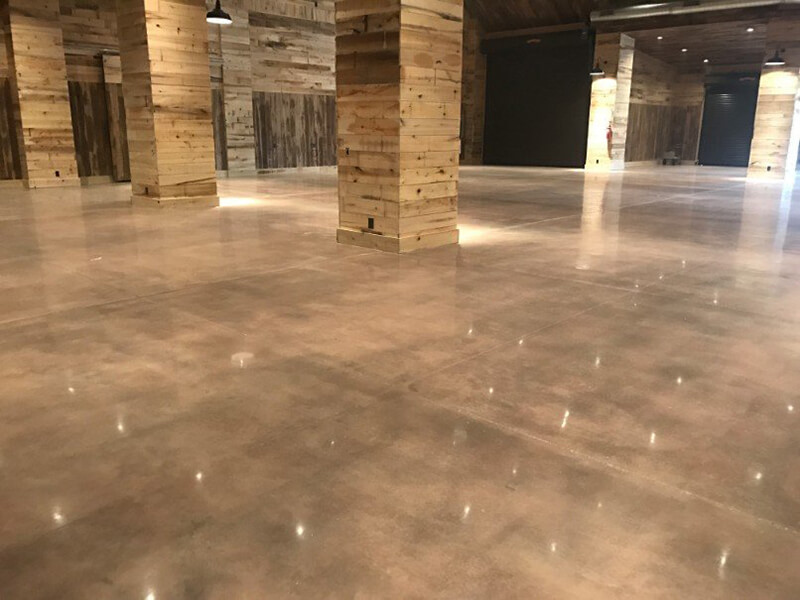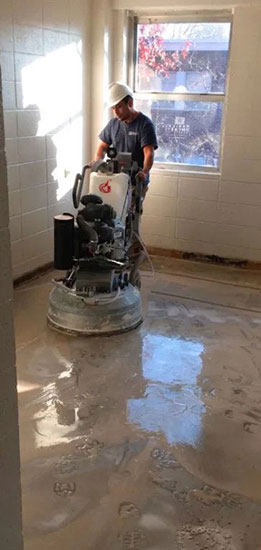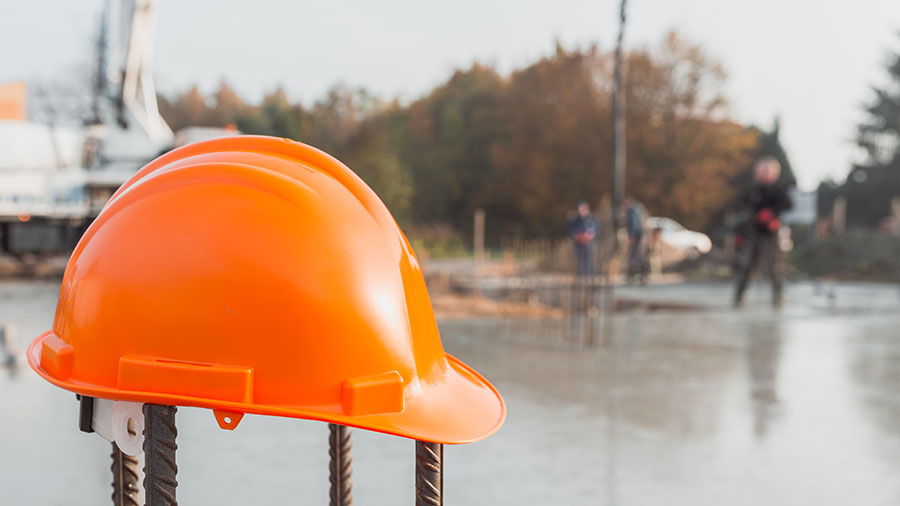Concrete Polishing
What Is Polish Concrete ?
Our business is polished concrete floors, acid staining floors, and dyed concrete. Our polished concrete floors, acid stained floors and dyed concrete floors are found throughout the Mid Atlantic area in government facilities, schools, retail and commercial applications. We provide concrete polishing services to architects, business owners, general contractors and project management companies. We see your polished concrete flooring project through until the end; from the specification process to maintenance of your project. We offer a turnkey polished concrete process. We use the ULTRAFLOR ARDEX DIAMATIC Polished Concrete System. The ULTRAFLOR System is the only comprehensive polished concrete system with a detailed written process specifications for all aspects of the installation. We can ensure you a successful installation of your polished concrete floors, acid stained concrete floors and dyed concrete floors done on time and on budget.
For more information on our concrete acid staining or polished concrete systems, call us (647) 882-5043

We use environmentally friendly concrete polishing systems. These green concrete products and sustainable processes have a proven success record. In addition, we offer our clients an extended warranty on both our product and labor. We use the most advanced equipment and constantly update our concrete polishing methods to stay on the cutting edge of this rapidly changing technology. Be sure to utilize our unsurpassed expert advice for your polished concrete floors, dyed concrete floors and acid staining floors.
For Terrazzo floors we use gentle, professional polishing to bring the life and shine back every now and then. Terrazzo flooring is a work of art in itself. Did you know Terrazzo originated in Italy as a mishap creation? Italian mosaic artisans would cast aside the remnant marble chips from their projects onto terraces in the process of being built. Over time people stepping back and forth over the terrace floors would cause the littered marble chips to be pushed further down. Shuffling feet would cause the floors to be smoothed to a polish. This idea has been refined over the centuries and it is still a widely used concept today. Terrazzo polishing will prolong the life of your work of art.
For your commercial or residential concrete contractor needs, we can repair or demo your concrete and clean up the mess. For an affordable and knowledgeable solution to your flooring issues feel free to contact us. From floor prepping, leveling and grinding to concrete work and Terrazzo polishing we can do it all give Concrete Repairman a call.
Polished concrete floors are easy to install and maintain, offer increased strength and durability, and will decrease your floor maintenance and cleaning costs. Acid staining concrete floors or updating your industrial flooring with dyed concrete can make your facility more attractive, yet more cost effective at the same time. Contact us today to see how.
Do you have Terrazzo floors? If you do you know they need gentle, professional polishing to bring the life and shine back every now and then. Terrazzo flooring is a work of art in itself. Did you know Terrazzo originated in Italy as a mishap creation? Italian mosaic artisans would cast aside the remnant marble chips from their projects onto terraces in the process of being built. Over time people stepping back and forth over the terrace floors would cause the littered marble chips to be pushed further down. Shuffling feet would cause the floors to be smoothed to a polish. This idea has been refined over the centuries and it is still a widely used concept today. Terrazzo polishing will prolong the life of your work of art.
For your commercial or residential concrete contractor needs, we can repair or demo your concrete and clean up the mess. For an affordable and knowledgeable solution to your flooring issues feel free to contact us. From floor prepping, leveling and grinding to concrete work and Terrazzo polishing we can do it all give Concrete Repairman a call.
The successful completion of a diamond polished floor is dependent on two important factors:
- The quality of the concrete floor slab on which the diamond polishing will take place.
- The quality of the applied products and polishing equipment combined with the skill and abilities of the polishing company.
CPAA offers guide specifications to design professionals and the construction industry that addresses the second of these two important factors, however, the diamond polishing company has no control over the design, specification, or placement of the concrete floor slabs that are to be polished. To address the first of these two important factors, CPAA recommends the following design and construction recommendations be evaluated for inclusion in the Division 03 cast-in-place concrete specifications prepared by the project structural engineer.

DIAMOND POLISHED CONCRETE IS NOT TERRAZZO
A diamond polished concrete floor is not like terrazzo:
- Terrazzo is mixture of matrix and aggregates that are topically applied to a concrete floor then polished; diamond polishing is a process of finishing the concrete floor using grinding and polishing equipment along with concrete chemicals.
- Application of terrazzo and diamond polishing covers the concrete floor that was placed months earlier and followed by the construction of a building over it, however the terrazzo will cover the concrete floor but the diamond polishing finished the concrete floor that is there.
- The cementitious or epoxy matrix color can be selected for terrazzo, however, the concrete floor slabs is a product of the local concrete producer and there is very little, if any, ability to influence the color.
- Aggregates for terrazzo can be selected, however, the aggregates for diamond polished floors is the aggregate normally used by the concrete producer.
The point is that a diamond polished concrete floor cannot be thought of as a terrazzo floor. It is a different process that is not a covering and depends on heavily on the quality of the concrete. EARTH SUBGRADECPAA recommends fine grading the subgrade uniformly flat using a laser device.
Imperfections in the subgrade surface, such as rises and depressions, could cause variations in the thickness of the concrete which increases the possibility of cracking because of restricted movement. A uniformly flat subgrade surface reduces the potential of cracking because the concrete slab can expand and contract with minimal friction. While cracks can be filled during the polishing process, they cannot be made invisible by the polishing contractor. Also, depressions in the subgrade could allow bleed water to pool on top of the below slab vapor barrier during plastic state of concrete which could cause blemishes in the concrete surface because of the differential curing and drying. Blemishes such as this cannot be eliminated by the polishing contractor. BELOW SLAB VAPOR BARRIER Moisture movement from earth subgrade through the concrete slab-on-grade to the concrete surface is a major problem in the flooring covering industry today, and can adversely affect a polished finish as well. A high-performance vapor barrier between the subgrade and the concrete is extremely important, therefore CPAA recommends a membrane that is rated Class A according to ASTM E1745 – 09 Standard Specification for Water Vapor Retarders Used in Contact with Solid or Granular Fill under Concrete Slabs that has the following properties:
- Permeance: Not more than 0.1 perms (grains/sq ft/hr/in-Hg) after conditioning testing according to Section 7.1 of ASTM E154 – 08a Standard Test Methods for Water Vapor Retarders Used in Contact with Earth Under Concrete Slabs, on Walls, or as Ground Cover.
- Thickness: Not less than 15 mils.
- Tensile Strength: Not less than 45 lbf/in.
- Puncture Resistance: 2200 grams.
Installation of the vapor barrier should comply with ASTM E1643 – 09 Standard Practice for Selection, Design, Installation, and Inspection of Water Vapor Retarders Used in Contact with Earth or Granular Fill Under Concrete Slabs. CONCRETE MIX DESIGN In addition to ACI standards for mixing concrete, CPAA recommends the following:
- For the portion of the concrete that will be polished, each mix ingredient should be from the same source, from the same respective batch, and each delivered to the concrete producer in one delivery.
- Type I portland cement according to ASTM C150 – 09 Standard Specification for Portland Cement.
- A water-to-cement (W/C) ratio is .45.
- One of the strengths of diamond polished concrete is the range of aggregates that can be exposed, therefore a uniformly graded mix of not less than 3 aggregate sizes – fine, intermediate, and large – will yield the best visual quality. It should be understood that since aggregates are heavy and there is a cost for transporting aggregate from its source to the batch plant is a factor in the cost of the concrete, locally available aggregates are used to produce concrete. This is an important design consideration because, depending on the project location, there may be few, if any, opportunities for other aggregates to be used in the concrete mix.
- The mix should not be air entrained.
- Inclusion of admixtures, plasticizers, slag, fly ash, or other products replacing portions of the portland cement in the concrete mix is not recommended. If any of these are used, the total volume should not exceed 20 percent of the portland cement volume.
- Admixtures should not be calcium chloride based.
- If an integral color is included in the concrete mix, the minimum batch size should be 3 cubic yards.
- During batching, the incoming material consistency should be monitored and controlled.
- The compressive strength should not be less than 3,500 psi.
PLACING CONCRETE
In addition to ACI standards for placing concrete, CPAA recommends the following:
- Transit mixer drums should be properly washed out after each concrete mix discharge and before a new batch is loaded.
- Water added by the transit mixer driver should be monitored and controlled.
- During mixing, transporting, and placing the concrete mix, monitor and control the temperature to not more than 85 degrees F.
- The slump at the point of discharge should be 5 inches, plus or minus 1/2 inch.
FINISHING CONCRETE
In addition to ACI standards for finishing concrete, CPAA recommends the following:
- After placement of the concrete mix, strike off the surface using a laser screed, then bull float at 90 degrees to the screed pull direction, vib and consolidate, and level to specified elevation. A 10 foot check rod is recommended, however, if not available bull floats should be 6 foot long; smaller bull floats may be used on sloping surfaces.
- When placing concrete mix at edges, use a 36 inch long metal or wood edged screed and run parallel with the formwork or edge after the initial screeding and before floating. Hand floating should be parallel to the edge and performed in 24 inch increments to avoid lifting or depressing the surface. Avoid pulling excessive amounts of the concrete mix to the edges by either not using hand tools more than 24 inches from the edge, or floating in a fan direction.
- When little or no bleed water is present and concrete mix has sufficiently hardened to support finishing equipment without causing imperfections in the surface, begin machine floating using pans and make two passes.
- To improve the possibility of achieving the specified flatness/levelness requirements, check and re-straighten if necessary using a 10 foot or longer highway straight edge or bump cutter.
- When machine floating edges, use pans and overrun the formed edge by 5 inches. For both walk-behind and riding equipment, make the first pass along the edge with the left side, or cutting side, of the equipment to pull down high spots of the surface. Make a second pass along the edge with the right side, or filling side, of the equipment to fill low spots in the surface.
- Steel trowel the surface in three passes without burning the surface or burning the aggregate (plastic trowel blades will prevent burning the aggregate).
- Lightly hand or machine tool edges construction joints and exercise care that edges are not depressed or chattered along bulkheads, formed edges, columns, and pipe penetrations.
- Do not dust the finished surface with dry portland cement or sand to accelerate curing and drying.

CONCRETE CURING AND DRYING
CPAA recommends evaporation control and wet curing concrete slabs according to ACI 308R-01: Guide to Curing Concrete (Reapproved 2008) without the use of topically applied curing compounds. While topically applied curing compounds may assist with curing during the first few days after concrete placement, they retard concrete drying in the weeks and months after curing and may cause the slab to be too wet when the time comes for diamond polishing or floor covering application. Densifiers and hardeners should not be applied to concrete. FLOOR FLATNESS/LEVELNESS CRITERIA CPAA recommends specifying the following tolerances:
FLOOR FLATNESS SPECIFICATIONS: ASTM INTERNATIONAL The floor flatness and levelness should be tested within 8 hours after completion of the final troweling operation according to ASTM E1155 – 96(2008) Standard Test Method for Determining FF Floor Flatness and FL Floor Levelness Numbers by an independent testing agency experienced with the testing procedure and possessing the necessary equipment. Additionally, a remedy for out-of-tolerance work should be specified. CONTRACTION JOINTS Based on independent studies, CPAA recommends saw-cutting slabs as soon as possible after finishing using a saw blade that has a triangular arbor configuration to reduce edge raveling or dislodging aggregates at the following spacing to minimize slab curling and cracking:Since concrete shrinks during curing and drying in two directions, cracks are minimized when the area between contraction joints is as close to a square as possible. PROTECTION CPAA recommends the concrete finishing specification include a requirement that the finished concrete slab comply with the damage and stain prevention provisions specified in the diamond polishing concrete floors specification.










